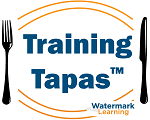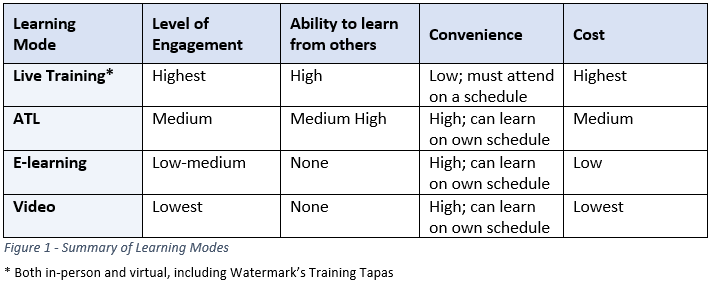
When it comes to learning in today’s business climate, we are fortunate to have more options than ever. When I first started in business we could attend in-person classes at a local university or at the American Banker’s Association. Training modes have advanced considerably since then with the Internet enabling the most significant progress.
The Past
In those early years of my career most training was done using traditional classroom methods, but the bank where I worked supplemented that with some “self-paced” courses. You might have certain connotations today when you hear the words “self-paced,” but back in those days it was either a do-it-yourself workbook or more often a boring talking head video. My colleagues and I spent many a sleepy hour watching them and I’m sure we learned a little as we watched the tapes. (They were not computer based originally, but yes, VHS tapes.)
When I joined a consulting firm after leaving the bank we still used video training and self-study books. I was lucky to have had a few clients with extensive video libraries that I could access as well. Still, they were not very engaging and I rarely if ever finished any of them. They helped the most when I took good notes and was able to apply the material immediately. Sadly, that didn’t happen nearly enough.
The Present
Fast forward to today and you will find considerably more options for learning. Many, if not most students say they learn the best in an in-person classroom environment. Besides in-person classes we have the option of learning virtually from a computer or tablet. That has been a revolutionary concept in the training industry and has transformed our field. Despite preferences for in-person learning, the realities of schedules, budget, and physical locations often limit the options.
With their ability to reach anyone with a broadband connection, the option of virtual classes solves those constraints. Our company has found that these live virtual deliveries have grown in popularity every year since we first started offering them in 2010.
If you need even more schedule flexibility in your learning, there are numerous self-paced training options. They range from a short “learning byte” video on You Tube to longer mini class videos from providers such as Courseara, udemy.com, or LinkedIn (via Lynda.com). While some videos are engaging, even entertaining, they suffer from their lack of skill transference. At their best, videos can be inspiring, but at their worst, are a waste of time and give people the false impression they are building skills.

E-learning has evolved immeasurably from early computer “page flipping” to today’s sophisticated interactive modes. The level of engagement can vary widely, though, and much e-learning today tends to be self-running PowerPoints with voiceovers. While those can be economical, they suffer from lack of interactivity and engagement. They have even less opportunity than videos to inspire or entertain.
The Future
To address the shortcomings of video and e-learning, several years ago our company launched a new category that we call Anytime Learning (ATL). This format combines the engagement of live training with the convenience of self-paced modes. ATLs are recordings of live, virtual classes that can be accessed at “any time.” We think of them as “the next best thing to being in class.” Here are their major features:
- Students “attend” a course by viewing recordings through the Internet and completing exercises as if they were attending the live version. People receive the same materials as are provided in a live class.
- Attendees hear the questions of other students in the class and the instructor’s answers. That provides a boost to learning that videos and e-learning cannot do. It also increases the level of engagement with the material. One ATL student of ours said about his engagement with the class:
- ATL users can get their own questions answered by emailing an instructor during their access period. The answer is slower of course compared with a live class, but the convenience and lower costs of this method make up for it. This feature allows our ATLs to earn qualifying Professional Development hours towards certifications such as CBAP, PMP, and others. Videos and e-learning without this feature don’t qualify.[1][2]
- Our company has provided professional training for over 25 years. We have seen the length of classes decrease from an average of 4-5 days in the 1990s to one or two days or less today (at least for non-certification classes). Whatever the cause, organizations and individuals need shorter learning segments, which helps explain the rise of self-paced options. That doesn’t mean people are necessarily happy with the options or are able to learn from them.
 That prompted us to launch a new mode we call Training Tapas™. Tapas are snacks that originated in Spain. They are larger than a bite and smaller than a full meal. Our Training Tapas are half-day sessions focused on one skill or topic and hit the sweet spot between a video or webinar and a longer class. They are long enough to let participants delve into a topic to learn and practice it, but short enough to fit into busy schedules and project demands. They can be accessed in both live or ATL formats depending on needs and preferences. They can also be combined into longer “meals” to address a series of related topics, which can be spread over time if need be.
That prompted us to launch a new mode we call Training Tapas™. Tapas are snacks that originated in Spain. They are larger than a bite and smaller than a full meal. Our Training Tapas are half-day sessions focused on one skill or topic and hit the sweet spot between a video or webinar and a longer class. They are long enough to let participants delve into a topic to learn and practice it, but short enough to fit into busy schedules and project demands. They can be accessed in both live or ATL formats depending on needs and preferences. They can also be combined into longer “meals” to address a series of related topics, which can be spread over time if need be.
Summary
We have many options today for obtaining knowledge and acquiring new skills. See Figure 1 for a summary of the modes described above. I personally have used all the methods at one time or another.
My comments about some of the limitations of video and e-learning haven’t stopped me from using them. Within the last year I’ve watched video courses on Design Thinking, Search Engine Optimization, and Travel Photography. While all have been useful to some degree, it’s also telling that I have completed none of them. We think our ATL classes that blend a live class recording (that people are more likely to finish than other modes) with the ability to go at your own pace offers the right balance of hybrid learning.
What do you think? Please share your thoughts and observations below.

[1] Source: IIBA CBAP Certification Handbook
[2] Source: PMI PMP® Handbook
Richard Larson, PMP, CBAP, PMI-PBA, was the founder of and is now a consultant for Watermark Learning. He is a successful entrepreneur with over 35 years of experience in product development, business analysis, project management, training, and consulting. As an internal entrepreneur, Rich led the development of several Watermark Learning online products as a business analyst and product owner.
Rich is a frequent speaker at Business Analysis and Project Management national conferences and IIBA® and PMI® chapters around the world. He has contributed as a lead author to the BA Body of Knowledge version 2.0 and 3.0 and was a lead author on PMI’s Business Analysis Practice Guide. He and his wife Elizabeth Larson have co-authored five books on business analysis.


 New Horizons
New Horizons
 Project Management Academy
Project Management Academy
 Six Sigma Online
Six Sigma Online
 Velopi
Velopi
 Watermark Learning
Watermark Learning
 Login
Login





 New Horizons
New Horizons
 Project Management Academy
Project Management Academy
 Velopi
Velopi
 Six Sigma Online
Six Sigma Online
 Watermark Learning
Watermark Learning